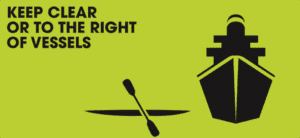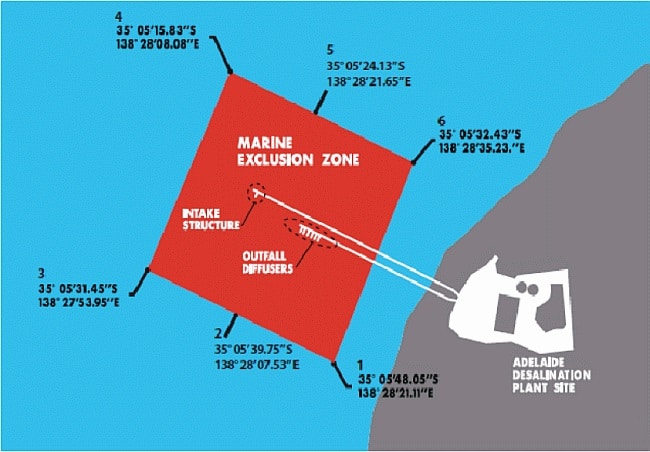
Being safe on the water starts with always wearing your lifejacket. A properly fitted lifejacket feels snug and comfortable to wear. Find one that suits you and your needs.

Let someone know before you go and tell them where you are going, your departure point and when you intend to return. If you change your plans, let them know

Stay clear of large vessels and keep out of shipping channels. Learn the right of way rules. You must always navigate on the right (starboard) side of a river or channel.
It is important to consider safety before and during the use of a kayak, canoe or a similar unpowered vessel. Be mindful of how the craft is susceptible to weather and other risks such as capsizing, blowing off course, taking on water and not being visible to faster larger boats.
As the paddler you are responsible for your safety and the safety of any other people in your canoe/kayak. If you are paddling with a group be aware of how everyone is paddling to make sure they are not in any stress or dangerous situation.
Before going out on your paddle you should always check safety equipment is in order and take provisions such as water, snacks, sunscreen, phone and let friends and family not with you your location and time you intend to return. Also knowing the weather and how it will affect your paddle is important.
A Paddle Safe DVD is available from:
The Boating Safety Unit
13 Kateena Street
Regency Park
dpti.recreationalboatingunit@sa.gov.au
Phone: 1300 183 046

Take note of these five vital checks when planning your boating trip: • Warnings current for your paddling area • Weather conditions affecting safe navigation and comfort • Wind conditions • Wave conditions • Tide times. Be prepared to defer your plans until another day if the winds are too strong and the waves are too big. Check the weather at bom.gov.au/marine

You may need to communicate in an emergency or advise someone of a change of plan. Your means of communication can range from a mobile phone, flares or a distress beacon. Mobile Telephone: Carry a mobile phone in a waterproof bag.

Paddle craft sit low to the water and can be difficult for other boats to see. Make yourself visible by wearing bright clothes and using reflective tap on your paddle. Consider fitting a flag to your craft, and use a bright all-round light at night
Take a Paddle SA on-water Course. The on-water instruction courses provide the information you need for canoeing, kayaking, safety & rescue. Courses are run at Aquatic Reserve Bower Rd West Lakes SA. Scroll to the bottom of this page to see the next courses.
Wear Your Lifejacket (PFD) – Expect to capsize and swim occasionally when paddling. Learn more about PFDs and how they might just save your life.
Rules of the water – What paddlers need to know when sharing the waterways
Safety Check – Create a list you need to do before and during your paddles.
Paddlers don’t often consider water quality issues before getting into their boat, however depending on the type of paddling activity you are involved in it might be as well to give it some thought. It is well known that heavy sustained rain or storm activity can have an effect on water quality. In both urban and rural environments there is an increased risk of human and animal waste entering the waterways which then has the potential to cause harm to recreational water users. Storm and rain run-off may also wash chemicals and road-grime into waterways which are used for recreational paddling.
Paddling as an activity is secondary contact with the water. (see the definition of secondary contact below). Some paddling activity such as white-water, slalom, kayak surfing and canoe polo, may be classified as primary contact. (see the definition of primary contact below)
Please note: Primary contact water activities should be limited after heavy sustained rain or storm activity where greater than 10 mm of rain has fallen.
All paddlers should note that recreational water may contain pathogens. This applies to bodies of water such as lakes, rivers and the marine environment. Pathogens may enter the body through mucous membranes in the eyes, ears, nose or throat or through cuts or abrasions in the skin.
Common infections that people may suffer from contact with poor quality water are eye, ear, nose or throat infections. A common illness is gastroenteritis (from swallowing poor quality water). Some water borne pathogens may cause serious infections or illness and possibly death.
Some simple things that you can do to protect yourself from harm:
All paddlers should use common sense in determining when and where to paddle
Primary Contact (whole body contact) – activity in which the whole body or the face and trunk are frequently immersed or the face is frequently wet by spray, and where it is likely that some water will be swallowed or inhaled, or come into contact with ears, nasal passages, mucous membranes or cuts in the skin (eg swimming, diving, surfing or whitewater canoeing).
Secondary contact (incidental contact) – activity in which only the limbs are regularly wet and in which greater contact (including swallowing water) is unusual (eg boating, fishing, wading), and including occasional and inadvertent immersion through slipping or being swept into the water by a wave.
Pathogens are biological agents such as virus, bacteria, prion or fungus that causes disease to its host. Commonly known as germs.
Six marker buoys have been installed to mark the boundaries of a permanent exclusion zone that came into effect on Monday 15th August 2011.
Each of the marker buoys will be lit, yellow in colour, with a St Andrews topmark and a range of 3 nautical miles. Co-ordinates are in WGS 84 datum:
No 1. 35 degrees 05′ 48.05″ S, 138 degrees 28′ 21.11″ E. Flashing Yellow every 3 secs.
No 2. 35 degrees 05′ 39.75″ S, 138 degrees 28′ 07.53″ E Flashing Yellow (2) every 10 secs.
No 3. 35 degrees 05′ 31.45″ S, 138 degrees 27′ 59.95″ E. Flashing Yellow every 5 secs.
No 4. 35 degrees 05′ 15.83″ S, 138 degrees 28′ 08.08″ E. Flashing Yellow every 5 secs.
No 5. 35 degrees 05′ 24.13″ S, 138 degrees 28′ 21.65″ E. Flashing Yellow (2) every 10 secs.
No 6. 35 degrees 05′ 32.43″ S, 138 degrees 28′ 35.23″ E. Flashing Yellow every 3 secs.
The south east boundary of the zone will be approximately 500 meters off the shore from the Adelaide Desalination Plant site providing a channel to allow smaller vessels to pass between the coastline and the exclusion zone. The permanent exclusion zone is in place to ensure the safety of all mariners in this area and to protect the marine monitoring equipment and the intake and outfall structures located within the boundaries of the exclusion zone. Unauthorised vessels and persons are prohibited from entering the area at all times.
The exception to this permanent exclusion zone will be for vessels that are used for the maintenance of the intake and outfall infrastructure, the marine monitoring equipment or the navigational aids; and for vessels used to undertake marine monitoring activities.
A Notice to Mariners will be issued confirming the permanent exclusion zone and signage will be in place at boat ramps to inform mariners of the permanent exclusion zone.
If you would like to receive any further information about these activities please contact the Project Information Line on 1800 812 362, email the project team at desalination@sawater.com.au or log onto the SA Water website www.sawater.com.au.
